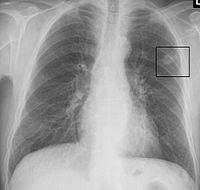
Photo from wikipedia
AIM To assess the rates of nodal and metastatic disease and change in management when staging part-solid T1 lung adenocarcinomas using integrated 2-[18F]-fluoro-2-deoxy-d-glucose (FDG) positron-emission tomography (PET)-computed tomography (CT) in… Click to show full abstract
AIM To assess the rates of nodal and metastatic disease and change in management when staging part-solid T1 lung adenocarcinomas using integrated 2-[18F]-fluoro-2-deoxy-d-glucose (FDG) positron-emission tomography (PET)-computed tomography (CT) in a UK population. MATERIALS AND METHODS This was a retrospective review of PET-CT examinations performed to stage radiologically suspected T1 part-solid lung adenocarcinoma (n=58) from two different centres. Rates of detection of nodal and metastatic disease, change in management, and final patient outcome were recorded. RESULTS PET-CT changed the stage in one patient from N0 to N1. It did not change final management in any patient. CONCLUSIONS In this UK population, PET-CT had minimal additional diagnostic benefit in staging patients with T1 part-solid lung adenocarcinoma. Especially given its cost, the inclusion of PET-CT for this indication in guidelines should be reviewed.
Journal Title: Clinical radiology
Year Published: 2021
Link to full text (if available)
Share on Social Media: Sign Up to like & get
recommendations!